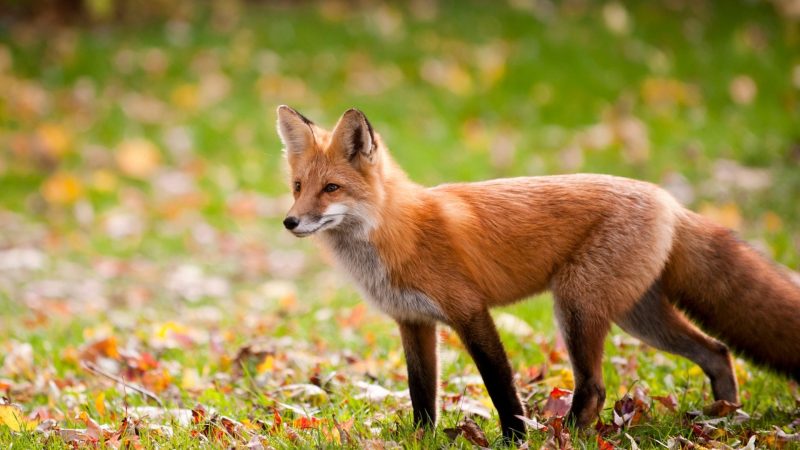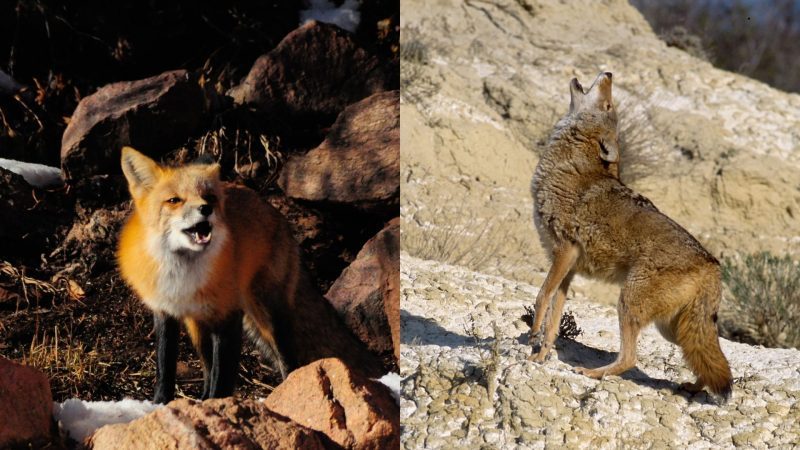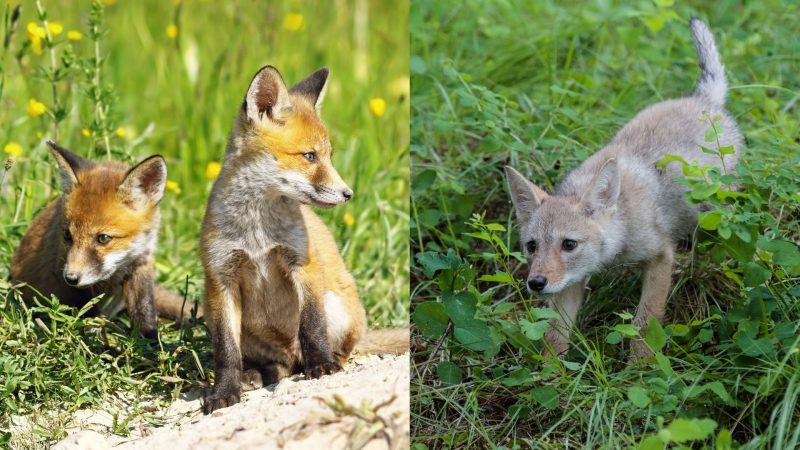When you see a heavily furred animal in your backyard with a medium built, ears pointing upwards, and elongated snout, you might instantly conclude that it is a fox. However, this is not always correct. Other members of the Canidae family look like them, and that includes coyotes. They are both mistaken as one for another due to their similarities in appearance, movements, and habits.
To differentiate foxes from coyotes, it is important to note some of their distinguishable traits:
- Foxes have pointier ears and bushy tails than coyotes.
- Coyotes are heavier in weight and have longer legs than foxes.
- Fox species have a wide array of colors, while coyotes have gray to brown coats.
- Coyotes are typically seen in packs, while foxes are solitary animals.
At this juncture, this article will let you discover the other identifying characteristics of foxes and coyotes, the effective ways of getting rid of them, their capacity to cause danger, and the indication and significance of their presence in backyards.
Table of Contents
Fox Identification

- Appearance: They have small to medium-sized body structures, triangular faces, pointed ears, pronounced canines, elongated snouts, and long, bushy tails. Also, they have whiskers on the head and limbs, which they use when navigating around their surroundings.
- Lifespan: They can live for 2 to 6 years in the wild and 10 to 14 years in captivity.
- Body Length: It may depend on the fox type, but they can be as little as 9 inches, while others grow to 34 inches.
- Weight: The smallest fox species have an average weight of 1 ½ to 3 ½ pounds, while the bigger ones are 9 to 19 ¼ pounds.
- Color: The colors of their fur and coats may depend on their breed. It may range from sandy, light brown, yellow, orange, reddish-brown, gray, black, and white.
- Place of Origin: It depends on the fox type. Some of them originate in North America and the arctic regions, while others came from Indian subcontinents, Central Asia, and European countries.
- Characteristics: They are very skilled hunters as it is their usual way of obtaining food. However, they do it solitarily and not in groups or in packs. They are also nocturnal creatures, so they are most active during nighttime and dusk. During the day, they take a rest in their dens and burrow, which they dig on their own. Other than that, they can be very adept at running, climbing, and jumping. They are not harmful to humans and pets unless put in jeopardy, undergoing extreme hunger, and afflicted with the rabies virus.
- Threat: Major threats to their population include frequent hunting, road accidents, loss of habitats and food sources, illegal animal trade, and diseases like canine parvovirus and rabies.
Coyote Identification

- Appearance: They look like young German shepherd dogs that have slender and narrow frames, muzzles, and faces. Their tails are long, bushy and typically carried very low, to the point that they appear to like being dragged while walking.
- Lifespan: They can live for 10 to 14 years in the wild, but they can exist for 18 to 20 years if they are held captive.
- Body Length: Their body length ranges from 3 feet, 3 inches to 4 feet, 5 inches, while their tails typically measure 16 inches.
- Weight: Males have an average weight of 18 to 44 pounds, while females have an average weight of 15 to 40 pounds.
- Color: Their top body structures are yellowish-brown to grayish-brown, while their underbellies have white fur. Other than that, they have black noses, yellow eyes, reddish-brown legs, and black-tipped tails.
- Place of Origin: They are natives of North America but have become prevalent in Mexico and Central America.
- Characteristics: They are regarded as social and amiable creatures but exercise monogamous matings. This animal fight with another coyote when there is a food shortage and typically marks their territories through urination and ground-scratching. They utilize their sense of smell, sight, and hearing when they hunt for food. If their prey is large, they will congregate in pairs or small groups. As to their method of communication, they use growls, whines, barks, and woofs.
- Threat: Their population is threatened by natural predators, such as wolves, grizzly bears, cougars, and black bears, hunting activities, availability of prey, extreme weather conditions, and loss of habitats.
How Big Is a Fox Compared to a Coyote?
Coyotes are generally bigger and larger than foxes. Their average height and length are around 24 inches and 3.5 to 4.5 feet, respectively, while their average weight is from 15 to 50 pounds. On the other hand, foxes are at least 14 to 12 inches as to height, 1.5 to 3 feet as to length, and 10 to 15 pounds as to weight.
Do Coyotes Have a Den?
Coyotes also have dens. They are nocturnal creatures. During the day, they mostly stay on the dens they dig and create themselves. These nooks are built under large boulders, hollow tree stubs, rock outcrops, or dens of other animals like skunks, squirrels, and raccoons. Furthermore, these habitats are also covered under bushes or trees so that their shelters could have a protective barrier.
Fox vs. Coyote Sounds

Both coyotes and foxes make screeching yells, howls, screams, yips, and yaps when they communicate. However, the sounds they produce may have slight differences. Although their sounds are both high-pitched, the outbursts of coyotes are prolonged and more extensive than those of foxes. Also, multiple howls may be heard from coyotes as they typically live in packs, while those from foxes may sound like two canids talking. These sounds may signify a lot of meanings, such as a call for food, mating, or the presence of danger.
Fox vs. Coyote Feces
The feces of foxes and coyotes may look similar at first glance. This may be because both of their feces have sharp, pointed ends, appear tan, brown, or white, or have bones, hairs, seeds, and bits of fruits in them. However, the feces of foxes usually measure two inches, while those from coyotes are bigger as it is at least four inches.
Should I Be Concerned About a Fox in My Yard?
The presence of foxes in the yard is not really an issue. They are generally not harmful to humans and pets, as most of them are only concerned with food. However, if they will cause damage to your properties just to obtain provisions, they may be an issue. Also, they may pose a threat and cause danger if they are put in a perilous situation, going through extreme hunger and tormented by the rabies virus.
What Attracts Foxes to Your Yard?
The presence of food supply attracts foxes to your yard. This may include birds, rodents, mice, voles, insects, rabbits, frogs, earthworms, and other small animals that can be found in your patios and gardens. Other than that, they may forage for fruits and vegetables that are planted in your yard as they are both plant and meat-eaters. Also, your backyard may be a good location for a den or burrow, so this may also entice them to stay and live in your outdoor space.
How to Get Rid of Foxes?
If you don’t want foxes to enter and roam around your place, it may be helpful to exercise the following practices:
- Inspect for the presence of fox dens and attractants in your area. Your premises may have edible food in the garbage, fallen fruits, and small animals, which may serve as a food source for foxes.
- Get rid of these shelters and attractants. These things may be the reason for your frequent fox spottings. To prevent them, remove any fox dens or fox attractants in your area. This can be done by regularly cleaning your surroundings, securing your pet’s safety, keeping food supplies properly, and disposing garbage in covered receptacles.
- Use fox repellents, deterrents, and other reliable methods of keeping them away. Mixing water and natural fox repellents, such as chili peppers, capsaicin, and garlic, can be efficient in keeping foxes from going near your place. This can be amplified when you utilize sound and noise deterrents, lights with motion sensors, and animal decoys that will scare and drive the said creatures.
- Put up a fence around your place. To prevent foxes from jumping over your area, put up a sturdy fence with a tall height. If fencing the entire property is difficult, you can put nets around your garden or in any areas where their food source is located. In doing this, make sure that the net openings are not more than three inches. The fence should be buried for at least one foot. This is to prevent foxes from digging and entering through it.
- Control the presence of small animals and pests around your backyard. These little creatures are an enticement for foxes. If rodents, small birds, voles, or frogs are prevalent in your garden, there is a high chance that they will keep on coming back to your place. As to your pets, look after them when they are outdoors.
Should I Be Worried About a Coyote in My Yard?
In the absence of any provocation or danger signs from coyotes, you should not worry about them being present in the yard. Most of these creatures tend to shy away from people and avoid human encounters as much as possible. Also, their main concern when they go outside is to look for food for themselves and their offspring. Therefore, if you don’t harm and threaten them, their presence should not be a problem.
What Attracts Coyotes to Yard?
Just like foxes, the availability of food in your yard is the primary reason why they are attracted to this place. When your outdoor area has rabbits, squirrels, mice, voles, and other small animals, you might just expect their regular presence in your yard. Also, if you have open garbage bins, compost piles, birdseed, and pet food in your garden, their frequent visits will not be a surprise. Other significant reasons for their attendance in your backyard include the presence of a water source and a possible place for a coyote nook.
How to Get Rid of Coyotes?
If you desire to get rid of coyotes, you may employ the following measures:
- Remove coyote attractants around your place. One of the reasons these animals have frequently been going in your place is the abundance of food supply. To prevent their unwanted visits, feed your pets indoors, and do not leave excess food outside. You should also pick up fallen fruits and store your garbage properly in closed bins.
- Put a fence around your property. To ensure that coyotes cannot go inside your property, it is advisable to put up a fence. The higher the fence, the lesser is the possibility for them to enter your premises. Shorter fences are not the best option as coyotes may just jump or leap over them.
- Apply coyote repellents. Coyotes abhor the scents of ammonia and mothballs. To deter their presence near your place, spray these substances or place ammonia rugs and mothballs along the perimeters of your area.
- Employ light and sound coyote deterrents. These animals will go away if they encounter light and sound deterrents around your place. This can be done by putting solar LED and motion-activated lights on your wall posts. You can also create loud noises or employ air horns, whistles, and other noise devices on your premises.
- Adopt a guard dog. Your dog best friend might just be a savior. This pet can potentially drive away predators such as coyotes. In scaring them away, bigger dog types can be an advantage.
- Assert your authority. Hazing coyotes induces fear in them and gives a message that their presence in your place is unwanted. You can assert your authority over them by shouting, making loud noises, or waving and making dictatorial hand gestures.
Which Is More Dangerous, Fox or Coyote?
Coyotes are more dangerous than foxes. This is due to their bigger size and heavier weight. These characteristics would work to their advantage when attacking or fighting with humans, predators, and other animals. Also, coyotes prey on larger farm animals and livestock, unlike foxes, who typically hunt for smaller creatures. Lastly, it is more common to see coyotes in urban and residential areas, so they pose an added threat to safety.
Will a Coyote Kill a Fox?
A coyote may kill a fox. This is possible if a coyote is threatened by a fox or put in a dangerous situation, necessitating him to attack and kill the fox intruder. If the coyote is extremely starving, there may even be a possibility that he will eat them. Also, it is said that these two creatures are natural enemies of each other.
Do Foxes and Coyotes Interbreed?

Foxes and coyotes cannot interbreed. Although they belong to the same family (Canidae), they cannot produce offspring when they mate. They do not have the same set of chromosomes that will capacitate them to bear a baby. Thus, it is impossible to have a biological father or mother that is a fox and a coyote.
Summary
Foxes and coyotes may have similar appearances, but it is undeniable that they also have differences. This includes their varying colors and the fact that coyotes are bigger and larger in size than foxes. It is important to distinguish these two creatures so that you can apply the appropriate remedy when these animals try to attack and pose a threat to you.
List of Sources
Wildlife Coyote. Fairfax County, Virginia.
Learn About Foxes. Commonwealth of Massachusetts.
Home & Garden Education Center: Coyote. University of Connecticut.
